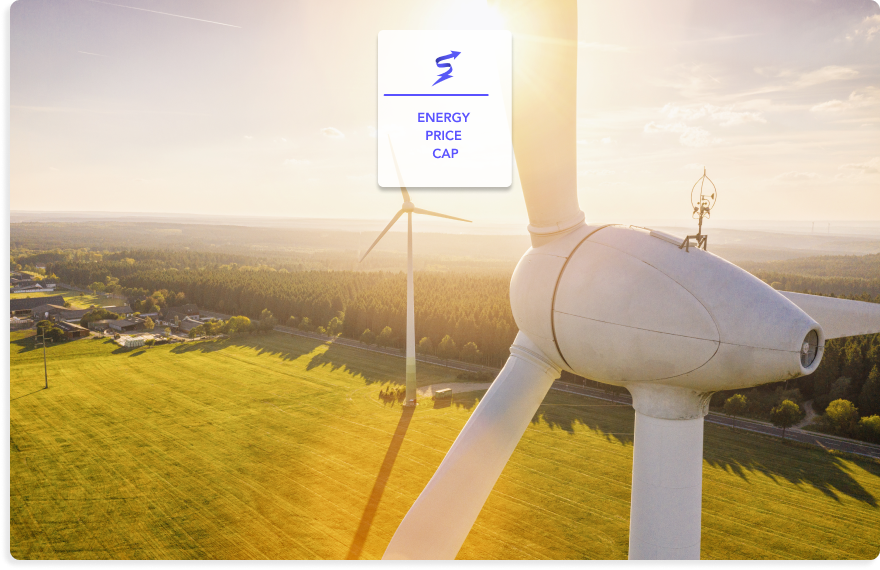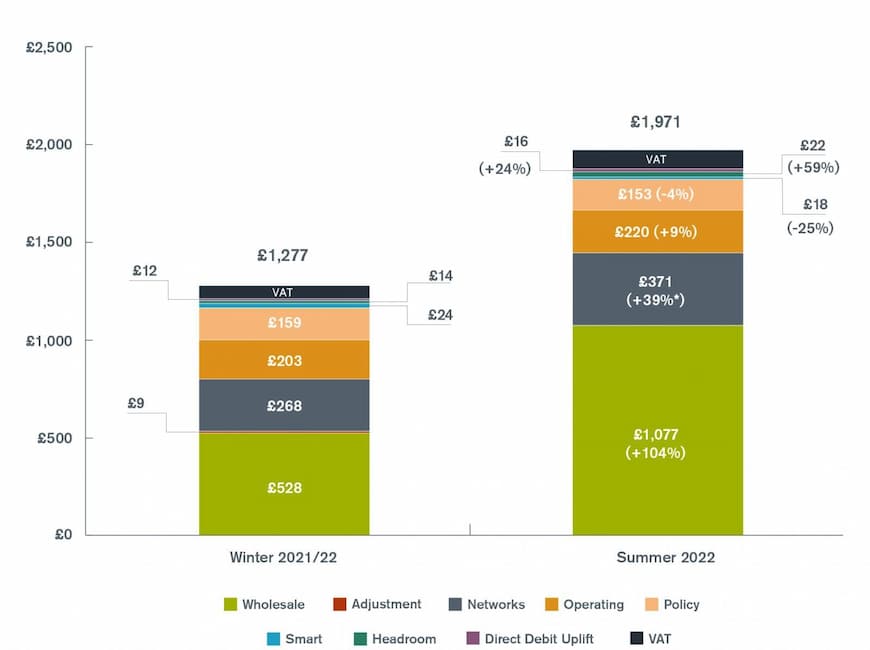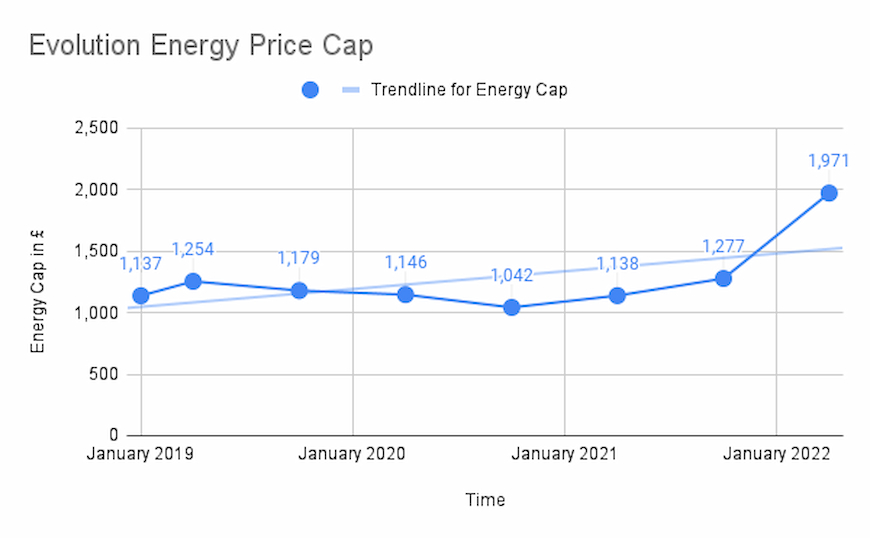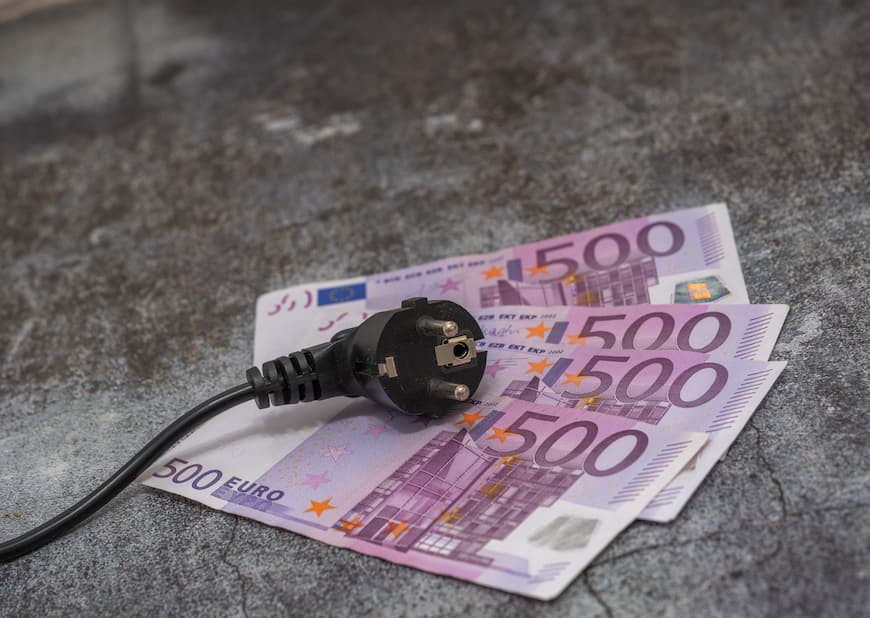Energy Price Cap to increase by £693 as of April 2022

Looking to switch over to Octopus Energy?
Learn more about the offers Octopus Energy has on the market!
Notice
On the 3rd of February, the Ofgem announced a staggering 54% in the energy price cap as of April 2022. Before, energy suppliers could charge a maximum yearly price of £1,277 pounds for default direct debit plans and £1,309 for prepayment plans. However, starting in April 2022 the cap will be £1,971 for default direct debit plans and £2,017 for prepayment plans. This sounds as a very worrying development, read on to find out why this policy changed and how the updated energy price cap could affect your personal bills.
Last updated: November 2022
Gas£863*£0.072 per kWh£492*£0.041 per kWh
| Payment Type | Fuel | New Energy Cap | New Energy Cap per kWh | Old Energy Cap | Old Energy Cap per kWh | %increase |
|---|---|---|---|---|---|---|
| Direct Debit | Dual fuel | £1,971* | £1,277* | +54.34% | ||
| Electricity | £812* | £0.28 per kWh | £609* | £0.21 per kWh | ||
| Gas | £840* | £0.07 per kWh | £480* | £0.04 per kWh | ||
| Prepayment Plan | Dual fuel | £2,017* | £1,309* | +54.08% | ||
| Electricity | £835* | £0.29 per kWh | £629* | £0.217 per kWh |
* $TDCV_warning$

Despite that steep increase, there are still space to compare energy prices and find good opportunities on the market.
What is the energy price cap?
The Energy Price Cap is the maximum price that energy suppliers within the United Kingdom can impose per kWh of electricity and gas. Although it is applied throughout the UK, but could vary slightly on a regional basis. The cap is set by Ofgem and is updated on a bi-annual basis in April and October. The energy cap limits energy companies from making large profits by charging unfair prices. The cap allows energy suppliers to pass on all reasonable costs to customers and was introduced by Ofgem in January 2019.
What is the energy price cap per kWh in 2022
Before, the average price cap per kWh was £0.21 for electricity and £0.04 for gas. Under the new regulations, the average price cap per kWh of electricity will be £0.28 and £0.07 for gas. These unit prices are then converted to a yearly average cap. Find here how the average consumption for the average price cap is calculated.
| Type | New Price per kWh | Old Price per kWh | % Difference |
|---|---|---|---|
| Electricity | £0.28 | £0.21 | +18.5% |
| Gas | £0.07 | £0.04 | +75% |
How is the energy price cap set?
The Energy price cap is based on a multitude of factors. The cap allows energy suppliers to be able to pass on costs of conducting business on to the customers but still leaving the customers with a fair price. There are quite a few different types of costs for energy suppliers that all contribute to the calculation of the energy price cap.
Costs influencing the energy price cap
The major components of the energy price cap are the underlying wholesale prices of gas and electricity. Increased wholesale prices for these commodities lead to increased operating costs for energy suppliers. These increased costs are then passed on to consumers in the form of higher prices. The following graph shows the breakdown of the energy price cap for the current cap and the breakdown for the updated cap of April 2022.

As you can see:
- The main increase came from the large rise in wholesale costs. Which is how much energy suppliers pay for gas and electricity.
- Also Network costs: which are costs related to building and maintaining the gas pipes and electricity to transport energy to your home have risen sharply recently.
- Operating costs, which are costs related to running an energy business such as billing and metering also have increased and thus allow for a higher cap.
- Taxes have increased by 59% in the last period and other minor costs such as Policy costs and Headroom costs have been rising slightly, however with marginal influence on the total cap.
Electricity Price Cap in my area
The energy price cap can differ between different regions within the UK. The Uk has been divided into 14 regions and each region has its specific rates.
In the following table, we have lined up the maximum rates for electricity per kWh for all of the different regions.
| Region | Fuel Type | Standard Credit Price Cap | Prepayment Price Cap | Other Payment Methods Price Cap |
|---|---|---|---|---|
| North West | Single Rate Electricity | £ 970.90* | £ 920.890* | £ 635.568* |
| Northern | Single Rate Electricity | £ 966.71* | £ 916.924* | £ 644.165* |
| Yorkshire | Single Rate Electricity | £ 973.17* | £ 923.033* | £ 641.733* |
| Northern Scotland | Single Rate Electricity | £ 994.35* | £ 943.033* | £ 664.512* |
| Southern | Single Rate Electricity | £ 987.50* | £ 936.569* | £ 649.572* |
| Southern Scotland | Single Rate Electricity | £ 990.96* | £ 939.834* | £ 644.062* |
| N Wales and Mersey | Single Rate Electricity | £ 1,034.71* | £ 981.154* | £ 683.932* |
| London | Single Rate Electricity | £ 983.194* | £ 932.509* | £ 649.516* |
| South East | Single Rate Electricity | £ 1,011.520* | £ 959.245* | £ 673.567* |
| Eastern | Single Rate Electricity | £ 991.575* | £ 940.423* | £ 654.539* |
| East Midlands | Single Rate Electricity | £ 968.057* | £ 918.205* | £ 638.430* |
| Midlands | Single Rate Electricity | £ 986.543* | £ 935.671* | £ 650.330* |
| Southern Western | Single Rate Electricity | £ 1,014.355* | £ 961.921* | £ 680.228* |
| South Wales | Single Rate Electricity | £ 998.975* | £ 947.402* | £ 665.840* |
* Based on Ofgem’s TDCV (2,900.00 kWh of ⚡ and 12,000.00 kWh of 🔥 per year).
Gas prices per region under the new energy price cap
Also gas prices are capped differently in each region. In the table below you can see the rates for gas per kWh for all of the different regions based on the newly updated energy cap.
| Region | Fuel Type | Standard Credit Price Cap | Prepayment Price Cap | Other Payment Methods Price Cap |
|---|---|---|---|---|
| North West | Gas | £ 995.290* | £ 966.50* | £ 552.92* |
| Northern | Gas | £ 981.220* | £ 959.07* | £ 542.79* |
| Yorkshire | Gas | £ 987.770* | £ 962.87* | £ 545.98* |
| Northern Scotland | Gas | £ 994.53* | £ 967.920* | £ 549.17* |
| Southern | Gas | £ 1,011.80* | £ 982.13* | £ 567.21* |
| Southern Scotland | Gas | £ 994.50* | £ 967.900* | £ 549.15* |
| N Wales and Mersey | Gas | £ 998.02* | £ 967.14* | £ 555.45* |
| London | Gas | £ 1,016.31* | £ 985.68* | £ 569.35* |
| South East | Gas | £ 992.48* | £ 964.82* | £ 554.02* |
| Eastern | Gas | £ 995.43* | £ 972.06* | £ 554.34* |
| East Midlands | Gas | £ 988.03* | £ 961.26* | £ 546.52* |
| Midlands | Gas | £ 998.24* | £ 969.12* | £ 553.32* |
| Southern Western | Gas | £ 1,011.39* | £ 985.41* | £ 570.47* |
| South Wales | Gas | £ 1,007.47* | £ 973.29* | £ 567.87* |
* Based on Ofgem’s TDCV (2,900.00 kWh of ⚡ and 12,000.00 kWh of 🔥 per year).
Dual rate electricity prices under the new energy price cap
It is often also possible to have a dual rate plan in which both electricity and gas are combined into one comprehensive plan. The table below displays the limits for dual rate plans for each region.
| Region | Fuel Type | Standard Credit Price Cap | Prepayment Price Cap | Other Payment Methods Price Cap |
|---|---|---|---|---|
| North West | Dual Rate Electricity | £ 895.160* | £ 843.72* | £ 839.24* |
| Northern | Dual Rate Electricity | £ 910.080* | £ 857.81* | £ 853.40* |
| Yorkshire | Dual Rate Electricity | £ 907.900* | £ 855.75* | £ 851.34* |
| Northern Scotland | Dual Rate Electricity | £ 943.690* | £ 889.55* | £ 885.30* |
| Southern | Dual Rate Electricity | £ 912.240* | £ 859.86* | £ 855.47* |
| Southern Scotland | Dual Rate Electricity | £ 910.840* | £ 858.53* | £ 854.13* |
| N Wales and Mersey | Dual Rate Electricity | £ 963.350* | £ 908.140* | £ 903.97* |
| London | Dual Rate Electricity | £ 907.400* | £ 855.280* | £ 850.87* |
| South East | Dual Rate Electricity | £ 939.180* | £ 885.310* | £ 881.03* |
| Eastern | Dual Rate Electricity | £ 912.660* | £ 860.250* | £ 855.86* |
| East Midlands | Dual Rate Electricity | £ 901.820* | £ 850.010* | £ 845.57* |
| Midlands | Dual Rate Electricity | £ 919.680* | £ 866.880* | £ 862.52* |
| Southern Western | Dual Rate Electricity | £ 955.590* | £ 900.800* | £ 896.60* |
| South Wales | Dual Rate Electricity | £ 939.940* | £ 886.020* | £ 881.750* |
* Based on the assumed use of 4,200kWh per year
What is the prepayment meter cap?
Up to 4 million houses in the UK have aprepayment meter installed. Prepayment meters differ from standard meters in a way that with prepayment meters, the client pays for the energy expenses upfront. Prepayment meters are capped slightly higher than default tariffs, with the average cap standing at £2,017. Which is £46 higher than the average cap for default tariffs.
Down below is the detailed Energy Cap for Prepayment Meters
Updated average Prepayment Energy Cap
Prepayment Plan Gas£863*£0.072 per kWh£492*£0.041 per kWh
| Payment Type | New Prepayment Energy Cap | New Prepayment Energy Cap per kWh | Old Prepayment Energy Cap | Old Prepayment Energy Cap per kWh | %increase |
|---|---|---|---|---|---|
| Prepayment Plan Total | £2,017* | £1,309* | +54.08% | ||
| Prepayment Plan Electricity | £835* | £0.29 per kWh | £629* | £0.217 per kWh |
* Based on Ofgem’s TDCV (2,900.00 kWh of ⚡ and 12,000.00 kWh of 🔥 per year).
What does the new energy price cap mean for me?
Most people will be affected by the update of the energy price cap. Only if you have a fixed tariff or when your supplier is exempt from the cap it might be possible that the price cap does not influence your personal plan. At the moment Ecotricity, Good Energy and Green Energy UK are the only suppliers that are exempt from the cap. These 3 companies thus such can impose rates that surpass the capped rate. About 22 million households in the UK will be affected by the price cap increase.
How the cap has changed over time?
The energy cap is updated twice a year in April and October. The new price is calculated based on gas and electricity prices and also other factors such as operating costs for energy suppliers, network costs, and headroom costs. The cap has been moving upwards over the last few years but an increase like this year is unprecedented. The graph below displays the evolution of the energy price cap over the last few years, clearly highlighting the current sharp increase.

| Date | Energy Price Cap Amount |
|---|---|
| January 2019 | £1,137 |
| April 2019 | £1,254 |
| October 2019 | £1,179 |
| April 2020 | £1,146 |
| October 2020 | £1,042 |
| April 2021 | £1,138 |
| October 2021 | £1,277 |
| April 2022 | £1,971 |
* Based on Ofgem’s TDCV (2,900.00 kWh of ⚡ and 12,000.00 kWh of 🔥 per year).
How does the energy cap work?
The price cap as the name implies puts a limit on how much you have to pay for your yearly energy bills. It does not imply that you will definitely pay the exact price of the cap as your personal supplier could give you a rate that is lower than the maximum. The price cap is based on average national consumption. If you consume more than average, your actual bills will be higher than the stated cap. To calculate your personalized energy cap, multiply the kWh price by the amount of kWh of electricity and gas you typically consume yearly. Another component of your bill is the so-called standing charge. Which is a daily charge which will be added to your bill on top of your consumption costs. Under the new cap for direct debit, daily standing charges are £0.45 for electricity and £0.27 for gas. This adds £0.72 *365 or around £265 to your yearly bill.
How will the price cap affect my bills?
Energy suppliers often use a higher energy cap to pass on more of the operating costs to customers. Especially since the wholesale prices of electricity and gas have seen such a sharp increase it is likely that the majority of the extra space under the new cap will be used by energy suppliers.
How much will my bill go up?
The average cap increases by roughly £670. This does not mean that your energy bill will increase one-for-one by this amount. How much your bill will increase exactly depends on your supplier. However, chances are that bills will increase significantly. Contact your supplier to enquire how high your bill will be exactly.
Is this increase gonna lead to the reopening of the market?
In the last months, many suppliers stopped taking new clients due to the stringent consequences of the energy crisis. It was simply impossible for suppliers to make profit or just break-even given the sharp increase in gas and electricity wholesale prices. The new energy cap could open up possibilities in this realm as their revenues could increase significantly due to the higher prices they could charge. There are signs that the market is starting to be reopened again shortly.
What impact will it have on tariffs?
The increased cap allows suppliers to charge substantially higher rates. To meet their increased costs of supplying energy, it is likely that suppliers will try to fully or partially offset the higher costs by increasing prices.

Are any suppliers exempt from the price cap?
A majority of the suppliers will be falling under the 2022 energy price cap. Ecotricity, Good Energy and Green Energy UK at the moment are the only companies that will not be part of the price cap. They are exempted by Ofgem because they offer clean renewable energy. Clients at these 3 companies could thus be subject to prices that are above the cap.
How do I avoid paying the cap?
The only way to not be subjected to the cap is to be on a fixed rate tariff. However, due to the rising energy prices over the last months, at the moment a fixed rate tariff will generally be very close to the actual capped price. Therefore switching to a fixed rate tariff might not be worth the effort at the moment. In the future, this could always change.
Does the price cap mean I don't need to switch?
Most of the suppliers all operate under the same price cap and will thus face a similar decision when setting their rates in the coming months. However, it could be that different suppliers will end up using different prices, with lower or higher increases under the new price cap. Therefore it could always be possible that you would be able to save some money by switching to a different supplier after the updated energy cap. You can check this page to compare different suppliers to check for potential savings.
Why has the energy cap changed?
The sudden big rise in the energy cap in the UK might stir questions about why and how this has happened. The single most important factor that has led to the changed energy price cap is the energy market crisis.
Energy market crisis
The past few months have been very eventful in the energy market. The main culprit of the crisis has been the rising gas and electricity prices in Europe. UK prices have risen sharply as well. They are still below average, despite the potential influence of Brexit on energy prices. The rising prices have seen a plethora of suppliers go bankrupt, with around 4 million households in the UK forced to switch as a consequence. In order to guaranty the stability of the market and enable the remaining suppliers to be profitable >Ofgem adapted the Price Cap.
Why have gas prices been rising?
- Demand for natural gas plummeted during the first lockdown following the Covid-19 crisis. The increased demand for gas following the loosening of covid measures. has put pressure on gas supply in Europe.
- Increased demand for natural gas from Asia, especially from China, has put additional pressure on European gas supplies.
- Due to the cold winter in 2020/21 the gas supplies have been lower than normal.
Why have electricity prices been rising
The heightened price for natural gas indirectly caused electricity prices to soar as well. One-third of British electricity is generated by burning natural gas. Following the increased costs of natural gas, electricity prices have followed as well. In the following article we explain in detail how electricity prices are being determined.
![]()
Why have energy firms collapsed?
Due to the rising prices and the energy cap being fixed at a certain level for half a year, many energy companies were troubled in the past months. This has even led to numerous energy suppliers being unable to generate enough revenue to cover their costs and subsequently unable to continue operating. Major examples include Avro Energy and People’s Energy who combined served approximately 800.000 clients.
What can I do to offset the increase?
The hefty increase in the energy price cap can seem worrying for consumers. Especially in times like these with high inflations and uncertainty regarding the long-term impact of Covid-19. Therefore, it is important to know what you can do yourself to decrease the potential impact of the higher energy cap on your personal situation.
Should I switch Energy Supplier right now?
It depends on the situation whether it is wise to switch suppliers. It could be the case that under the updated price cap another supplier might offer a better deal than your current one. However, this is certainly not always the case. A careful comparison of different offerings should be done before hastily switching to another supplier. Especially because all suppliers face the consequences of the crisis, it will be difficult to find a cheaper rate at a different company. We have an overview of the cheapest suppliers to help you.
How do I know if I’m on a price-capped tariff?
If you are not a client at Ecotricity, Good Energy, or Green Energy U, and have not fixed a pre-set tariff in the past your plan is subject to the price cap. Switching to a fixed tariff is still possible but often does not make sense as fixed tariffs are also increasing rapidly following the UK energy crisis.
What support is available?
Energy companies and the government are very aware of the consequences of the increased prices for consumers. Therefore, there are several options for consumers to get support. The most important are the council tax rebate and the energy bill discount scheme.
-
- Council Tax Rebate.
- Energy Bill Discount Scheme.
- Payment breaks.
- Winter Fuel Payment.
- Emergency credit for prepayment meter users.
- £140 Warm Home Discount
-
-
-
-
- is a one-time rebate offered by the government which offers consumers that are in council tax band A to D a £150 discount. Around 80% of the UK population is part of one of these 4 tax bands. To be sure that you apply for the council tax rebate,
-
-
- what band you are in on the government website
Council Tax Rebate
The council tax rebate
-
How will the Energy Bill Discount Scheme work?
Another important support measure is the Energy Bill Discount Scheme, this scheme allows consumers to have a £200 discount this year on their energy bills. The £200 will then be repaid by the customer over the course of the next 5 years in 5 instalments of £40.
How else can I protect myself from rising prices?
Apart from the support measures that are available for you, another way of protecting yourself from rising prices indirectly is by carefully analysing your energy consumption and finding ways of cutting your energy consumption. Here you can read how to reduce your energy consumption.
Switch now to prevent paying too much
Often, switching to a new plan and/or new supplier could help you decrease your bill by £100+. Start by comparing energy deals with us.
We can help to manage every aspect of your move from end-to-end. No hassle, no headaches… All you can have to do is sit back. Relax. And enjoy your incredible energy savings that are well below the Energy Price Cap!
Sound good?
Call us today on to find out more. We’re available from 8.30 am to 5.30 pm.
Available Monday to Friday from 8.30 am until 5.30 pm
FAQ
How can I top up my prepayment meter?
p>If you are on a fixed contract your bill will not increase immediately. However, as soon as your deal ends a new deal will very likely be significantly higher than your current one.
I have a prepayment meter, does my bill increase?
Yes, the energy price cap for prepayment meters also increases under the new regulations. The average price cap for prepayment meters will be £2,017 as of April 2022.
Are any suppliers not part of the price cap?
Ecotricity, Good Energy and Green Energy UK are not limited by the energy price cap.
Can I avoid paying for the cap?
Switching to a fixed rate program is the only way to avoid paying for the cap.
-
Updated on 29 Jan, 2024
Alex
Consumer Energy Expert
Comments
1 Ratings



 5/5
5/5